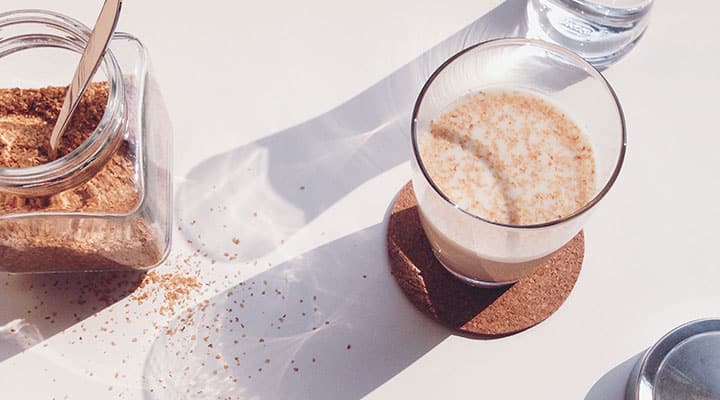
What Is Wheat Germ?
Published: April 2024
Wheat germ may make you think of an early 1980s breakfast table, back in the days when toast was topped with margarine (no worries back then about trans fats) and orange juice was seen as the perfect way to start your day (rather than a less-than-ideal alternative to a fiber-packed whole orange fruit).
Breakfast trends sure have changed since then, but perhaps it's time for a wheat germ revival!
Why? It turns out that the extraordinary ingredient found in the spiked top of the whole wheat plant is the most valuable component of whole grain wheat.
You might even call it a superfood: wheat germ is packed with nutrients that support our well-being. Like other foods (ranging from avocado to blueberries) that share this moniker, this nutrient-dense food promotes health and longevity in essential ways, from supporting digestive health to promoting a healthy life span.
Let's get acquainted with wheat germ's properties, health benefits and uses—then decide for yourself if you need more of it on your diet…if not in your breakfast, then as a healthy aging supplement!
What is wheat germ?
In the wheat plant, the whole grain (or wheat kernel) comprises three different edible parts: the bran, the germ and the endosperm. Although it composes up to five percent of the entire wheat berry, the germ is the healthiest and most nutrient-rich part of the plant.
Sadly, you don't get wheat germ from your average loaf of grocery store bread; it's actually just a by-product of the flour milling industry. Yet this by-product has so many health benefits! When you consume wheat germ, you not only gain the health benefits of an economical and highly nutritive plant-based product but also help reduce wheat milling waste.
What does wheat germ do for the body?
Wheat germ has massive health-promoting properties, which is no surprise when you consider that it's an excellent source of protein, fiber and healthy fats, and contains vitamins and minerals like folate, thiamine, magnesium, phosphorus and more. Let's dig into its impressive nutrient profile:
Essential nutrients:
Wheat germ is a wholly underused natural source of vitamins, minerals, fatty acids, and complex carbohydrates like fiber. Wheat germ is a rich source of vitamin E (tocopherol), a powerful antioxidant and critical for your blood, brain, and skin health. It's rich in B vitamins, thiamine, folate and zinc.Amino acids:
It is an excellent source of essential amino acids such as lysine and healthy fats like omega-3 fatty acids.Phytonutrients:
Wheat germ also contains polyamines, specifically spermidine. Spermidine intake is linked to healthy aging, cognition, and a fuller, healthier lifespan!
So, what does that mean for the body? Here's how those nutrients add up to all-around whole-body health benefits:
Healthy microbiome:
Studies suggest that the nutritional qualities of wheat germ promote a healthy intestinal microbiome, which is essential for everything from digestion to cognition and even immune support. This is because wheat germ exhibits prebiotic effects in your system. Prebiotics are food the healthy bacteria in your gut eat. So, wheat germ helps your natural gut microflora by making room for the health-promoting bacteria, such as Lactobacilli and Bifidobacteria.Supports healthy aging:
Spermidine is a polyamine, a plant compound that has been linked to a healthy lifespan and memory and cognitive health support.May even help with cardiovascular health:
Wheat germ is loaded with fiber. Increasing your fiber intake can help your body support LDL and HDL levels already within a healthy range. And studies suggest spermidine intake can support comprehensive heart health.
Where do I get wheat germ?
Wheat germ is available in a variety of forms:
Dietary supplement:
It is combined with other healthy aging-promoting nutrients such as taurine and lithium.Powder form:
It can be used as a topping to cereals, baked into muffins or mixed into soup.Other places you wouldn't expect it:
It's such a nutrient-packed food that it's been used to improve the nutritional value of milk pudding and to fortify dairy products like cheese and yogurt.
Wheat germ is also found in whole grain products, and minimally processed breads (aka, not your supermarket white bread or anything that isn't labeled as "whole grain"). Incidentally, this is one reason why white bread is less healthy than whole wheat bread: because many of the nutrients (including wheat germ) are lost during the milling process. When whole wheat is processed into white flour, the wheat berry is pulverized and stripped away of most of its nutrients, leaving only the starchy endosperm.
Milling whole wheat produces smooth, white flour, often used in cooking and baking, to create a product with a longer shelf-life. And be cautious: always check the ingredients to ensure they are made with whole grain; some "wheat products" may have been stripped down to the nutritionally empty endosperm.
Explore Our Best Anti-Aging & Longevity Supplements
Are Wheat Germ and Wheat Bran the Same?
You may have heard of wheat germ and wheat bran and be confused about the difference between the two (you're not the only one). They sound similar and are both part of whole wheat, but they are actually very different products!
The bran is the husk on the outside of the wheat kernel (which houses the endosperm), and it has some nutrients. However, wheat germ is the heart of the wheat plant, and that's where the nutrients are most dense. That's what makes wheat germ a rich and economical source of bioactive compounds.
Is it good to eat wheat germ every day?
Yes! Wheat germ is a fantastic daily staple. It contains many bioactive compounds that support overall health, in a miraculous little plant-based source. This can be especially inviting if you follow a vegetarian or vegan diet. Of course, always speak with your doctor before you start a new supplement or make big changes to your diet.
Note: Wheat germ does contain gluten, so people who avoid this protein in their diet may want to skip out on this food.
So, how can you reap the rewards of this nutrient-packed food? Use it as a topping. Wheat germ has a delightful nutty flavor with a breadcrumb-like texture that you can add to nearly anything edible. Add it to your breakfast bowl (hot or cold), bake it into some banana muffins, or use it in a smoothie. Or add it to your dessert as an ice cream or pie topping. Wheat germ is so versatile; it's also an alternative for breading meats such as meatballs, or making soups, casseroles, energy bars, muesli and more!
If you're always on the go and don't have time to bake or prep smoothies but still want this healthy aging nutrient in your stockpile of goodies, finding a high-quality supplement is a convenient and easy way to tap into the health-promoting benefits of wheat germ.
References
- Aune D, et al. "Whole grain consumption and risk of cardiovascular disease, cancer, and all cause and cause specific mortality: Systematic review and dose-response meta-analysis of prospective studies." BMJ. June 2016. https://www.ncbi.nlm.nih.gov/pmc/articles/PMC4908315/
- Boukid F, et al. "A compendium of wheat germ: Separation, stabilization and food applications." Trends Food Sci & Technol. August 2018. https://www.sciencedirect.com/science/article/abs/pii/S0924224418302541?via%3Dihub
- Cara L, et al. "Long-Term Wheat Germ Intake Beneficially Affects Plasma Lipids and Lipoproteins In Hypercholesterolemic Human Subjects." J Nutrition. February 1992. https://pubmed.ncbi.nlm.nih.gov/1732472/
- Kumar A, et al. "Major phytochemicals: Recent advances in health benefits and extraction method." Molecules. January 2023. https://www.ncbi.nlm.nih.gov/pmc/articles/PMC9862941/
- Liaqat H, et al. "Effect of wheat germ on metabolic markers: A systematic review and meta-analysis of randomized controlled trials. Food Sci Biotechnol. June 2020. https://www.ncbi.nlm.nih.gov/pmc/articles/PMC7256174/
- Mahmoud AA, et al. "Wheat germ: An overview on nutritional value, antioxidant potential and antibacterial characteristics." Food and Nutrition Sciences. February 2015. https://www.scirp.org/html/8-2701482_54019.htm
- Majzoobi M, et al. "Roasted Wheat Germ: A Natural Plant Product in Development of Nutritious Milk Pudding; Physicochemical and Nutritional Properties." Foods. June 2022. https://www.ncbi.nlm.nih.gov/pmc/articles/PMC9222632/
- Mohajeri M, et al. "Wheat germ, a byproduct of the wheat milling industry, as a beneficial source of anti-aging polyamines: A quantitative comparison of various forms." Food Sci Nutr. September 2023. https://www.ncbi.nlm.nih.gov/pmc/articles/PMC10630827/
- Moreira-Rosário A, et al. "Can wheat germ have a beneficial effect on human health? A study protocol for a randomized crossover controlled trial to evaluate its health effects." BMJ Open. November 2016. https://www.ncbi.nlm.nih.gov/pmc/articles/PMC5129044/
- Moreira-Rosário A, et al. "Daily intake of wheat germ-enriched bread may promote a healthy gut bacterial microbiota: A randomized controlled trial." Eur J Nutr. August 2020. https://pubmed.ncbi.nlm.nih.gov/31325040/
- Temple NJ. "A rational definition of functional foods: A perspective." Front Nutr. September 2022. https://www.ncbi.nlm.nih.gov/pmc/articles/PMC9559824/
- Villa MN, et al. "Functional food awareness and perceptions in relation to information sources in older adults." Nutr J. May 2014. https://www.ncbi.nlm.nih.gov/pmc/articles/PMC4032390/
- Wu H, et al. "The association of dietary spermidine with all-cause mortality and CVD mortality: The U.S. national health and nutrition examination survey, 2003 to 2014." Front Public Health. September 2022. https://www.ncbi.nlm.nih.gov/pmc/articles/PMC9554131/
- Zong G, et al. "Whole grain intake and mortality from all causes, cardiovascular disease, and cancer: A meta-analysis of prospective cohort studies." Circulation. June 2016. https://www.ncbi.nlm.nih.gov/pmc/articles/PMC4910651/
Always be in the know!
Access the latest deals, wellness news, expert health tips & more!










